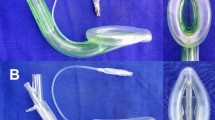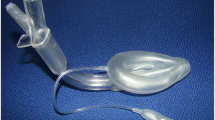Abstract
Background
A higher oropharyngeal leak pressure (OLP) is a marker of efficacy and safety when using laryngeal mask airway devices. The new disposable laryngeal mask airway (LMA™) Supreme™ has lower OLP compared with the LMA ProSeal™. Increased intracuff pressure of laryngeal mask airway devices may improve OLP but may result in more postoperative pharyngolaryngeal adverse events. This study was designed to compare the OLP of the LMA Supreme at varying intracuff pressures.
Methods
One hundred and twenty-three patients were divided randomly into three groups. General anesthesia was standardized using a propofol-fentanyl induction and desflurane in air-oxygen for maintenance. Intracuff pressures of the LMA Supreme were adjusted to 80 cm H2O, 60 cm H2O, and 40 cm H2O according to group allocation. The primary outcome was OLP. Secondary outcomes included postoperative pharyngolaryngeal adverse events and the satisfaction scores of patients and anesthesiologists. The OLP was compared amongst groups using analysis of variance with Bonferroni correction. All reported P values are two-sided.
Results
The OLP with an intracuff pressure of 80 cm H2O was significantly higher compared with 60 cm H2O and 40 cm H2O (26 [6] vs 20 [6] vs 18 [5] cm H2O, respectively; P < 0.001). The incidence of postoperative pharyngolaryngeal adverse events (P = 0.6), patient satisfaction scores (P = 0.2), and anesthesiologist satisfaction scores (P = 0.8) were comparable amongst the three groups.
Conclusion
An intracuff pressure of 80 cm H2O with the LMA Supreme is associated with a higher OLP compared with 60 cm H2O or 40 cm H2O without a greater incidence of postoperative pharyngolaryngeal adverse events. For a superior glottic seal when using the LMA Supreme, we recommend intracuff pressures up to 80 cm H2O.
Résumé
Contexte
Une pression de fuite oropharyngienne (PFO) élevée est un marqueur d’efficacité et de sécurité lors de l’utilisation de masques laryngés. Le nouveau masque laryngé (LMA™) jetable Supreme™ a une PFO plus basse que le LMA ProSeal™. Une pression intra-ballonnet accrue dans les masques laryngés pourrait améliorer la PFO mais pourrait également entraîner davantage de complications pharyngo-laryngées en période postopératoire. Cette étude a été conçue afin de comparer la PFO du LMA Supreme à différentes pressions intra-ballonnet.
Méthode
Cent vingt-trois patients ont été aléatoirement répartis en trois groupes. L’anesthésie générale était standardisée pour tous : induction au propofol et fentanyl, puis maintien à l’aide de desflurane dans un mélange air-oxygène. Les pressions intra-ballonnet du LMA Supreme ont été ajustées à 80 cm H2O, 60 cm H2O, et 40 cm H2O selon le groupe. Le critère d’évaluation principal était la PFO. Les critères secondaires comprenaient les complications pharyngo-laryngées postopératoires et les scores de satisfaction des patients et des anesthésiologistes. La PFO a été comparée entre les groupes à l’aide d’une analyse de variance avec correction de Bonferroni. Toutes les valeurs P rapportées sont bilatérales.
Résultats
La PFO avec une pression intra-ballonnet de 80 cm H2O était significativement plus élevée que celle avec 60 cm H2O et 40 cm H2O (26 [6] vs 20 [6] vs 18 [5] cm H2O, respectivement; P < 0,001). L’incidence de complications pharyngo-laryngées postopératoires (P = 0,6), les scores de satisfaction des patients (P = 0,2) et les scores de satisfaction des anesthésiologistes (P = 0,8) étaient comparables dans les trois groupes.
Conclusion
Une pression intra-ballonnet de 80 cm H2O avec le LMA Supreme est associée à une PFO plus élevée qu’une pression de 60 cm H2O ou 40 cm H2O sans être accompagnée d’une incidence plus élevée de complications pharyngo-laryngées postopératoires. Pour une étanchéité glottique supérieure lors de l’utilisation du LMA Supreme, nous recommandons des pressions intra-ballonnet allant jusqu’à 80 cm H2O.
Similar content being viewed by others
References
van Zundert A, Brimacombe J. The LMA Supreme™ – a pilot study. Anaesthesia 2008; 63: 209-10.
Hosten T, Gurkan Y, Ozdamar D, Tekin M, Toker K, Solak M. A new supraglottic airway device: LMA-supreme, comparison with LMA-ProsealTM. Acta Anaesthesiol Scand 2009; 53: 852-7.
Keller C, Brimacombe JR, Keller K, Morris R. Comparison of four methods for assessing airway sealing pressure with the laryngeal mask airway in adult patients. Br J Anaesth 1999; 82: 286-7.
Eschertzhuber S, Brimacombe J, Hohlrieder M, Keller C. The Laryngeal Mask Airway Supreme™ – a single use laryngeal mask airway with an oesophageal vent. A randomized, cross-over study with the Laryngeal Mask Airway ProSeal™ in paralysed, anaesthetised patients. Anaesthesia 2009; 64: 79-83.
Seet E, Rajeev S, Firoz T, et al. Safety and efficacy of laryngeal mask airway Supreme versus laryngeal mask airway ProSeal™: a randomized controlled trial. Eur J Anaesthesiol 2010; 27: 602-7.
LMA™ Airway Instruction Manual. Revised 2005. LMA North America Inc., San Diego, CA, United States of America Available from URL: http://www.lmana.com/docs/LMA_Airways_Manual.pdf (accessed March 2011).
O’Kelly SW, Heath KJ, Lawes EG. A study of laryngeal mask inflation. Pressures exerted on the pharynx. Anaesthesia 1993; 48: 1075-8.
The LMA Supreme Instruction Manual. Maidenhead: Intravent Orthofix Ltd; 2007.
Goldman AJ, Langille D, Freund P, Flacco M. Evaluation of the LMA Supreme™: a sizing and troubleshooting study. Anesthesiology 2009; 111: A63. (abstract).
Chung F. Recovery pattern and home-readiness after ambulatory surgery. Anesth Analg 1995; 80: 896-902.
Chung F, Chan VW, Ong D. A post-anesthetic discharge scoring system for home readiness after ambulatory surgery. J Clin Anesth 1995; 7: 500-6.
Brimacombe J, Holyoake L, Keller C, et al. Pharyngolaryngeal, neck, and jaw discomfort after anesthesia with the face mask and laryngeal mask airway at high and low cuff volumes in males and females. Anesthesiology 2000; 93: 26-31.
Keller C, Puhringer F, Brimacombe JR. Influence of cuff volume on oropharyngeal leak pressure and fibreoptic position with the laryngeal mask airway. Br J Anaesth 1998; 81: 186-7.
Brimacombe JR, Brimacombe JC, Berry AM, et al. A comparison of the laryngeal mask airway and cuffed oropharyngeal airway in anesthetized adult patients. Anesth Analg 1998; 87: 147-52.
Wong JG, Heaney M, Chambers NA, Erb TO, von Ungern-Sternberg BS. Impact of laryngeal mask airway cuff pressures on the incidence of sore throat in children. Pediatr Anesth 2009; 19: 464-9.
Seet E, Yousaf F, Gupta S, Subramanyam R, Wong DT, Chung F. Use of manometry for laryngeal mask airway reduces postoperative pharyngolaryngeal adverse events: a prospective, randomized trial. Anesthesiology 2010; 112: 652-7.
Goldmann K, Hoch N, Wulf H. Influence of neuromuscular blockade on the airway leak pressure of the ProSeal laryngeal mask airway (German). Anasthesiol Intensivmed Notfallmed Schmerzther 2006; 41: 228-32.
Funding
Departmental funding supported the submitted works.
Funding
The laryngeal mask airway Supreme™ medical devices used in this study were supplied by Vitaid Canada Inc. Vitaid had no role in the design, analysis, or interpretation of the study.
Conflicts of interest
None declared.
Author information
Authors and Affiliations
Corresponding author
Rights and permissions
About this article
Cite this article
Zhang, L., Seet, E., Mehta, V. et al. Oropharyngeal leak pressure with the laryngeal mask airway Supreme™ at different intracuff pressures: a randomized controlled trial. Can J Anesth/J Can Anesth 58, 624–629 (2011). https://doi.org/10.1007/s12630-011-9514-6
Received:
Accepted:
Published:
Issue Date:
DOI: https://doi.org/10.1007/s12630-011-9514-6




